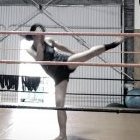Leaderboard
Popular Content
Showing content with the highest reputation on 02/17/2020 in all areas
-
Pacquiao has been hit in the face a million times. Conversely, he was KOd by a body punch ONCE and completely revamped his abdominal training in order to avoid that ever happening again. Body strikes suck. I totally get the Thai focus on balance. Once I became aware of it, this awareness made it very hard for me to watch a lot of western fighting, across all disciplines. Fighters are terribly off-balance during, before and after strikes. Imagine a gymnast landing on her ass or a diver belly-flopping into the water. That's what it looks like. Our eyes aren't looking for it, so a lot of western fans don't see it. But once you see it, you can never "un-see" it. It's pretty bad.3 points
-
There are a few things that are involved. The first may be that you have to keep in mind that Muay Thai evolved from rope bound fighting, where by report fights lasted very short periods of time, knock out or nothing, because they were basically barefisted. When hands were padded, this lengthened fights. I suspect that padding a part of the body devalued it. You are hitting someone with bare shin bones, or with padded hands. You can understand why the padded part might be devalued. Yes, if you rock someone, punches definitely count. But if you are just touching them stiffly, then nothing much. Punches need to have impact. Another element of this is that it is my theory that Thais and westerners map the body very differently. In the west we picture the head as the center of the self. Anything that strikes the head, even lightly, feels like it is hitting the very identity of a person. In Thailand you have a much more Old World conception of the body, something you see in traditional cultures, like those of Ancient Greece. In this view the "Gut" is a major center of self. In English we still have the vestigial belief in phrases like "gut check" or "I could feel it in my gut". For Thais, I believe, strikes to the gut, especially by kicks and knees, just FEEL like they are hitting the center of a person, more than they do in the west. Striking their vitality. In the traditional view of the body, the gut, the spleen, was a core of the self. Yes, the face also holds a symbolic sense of identity, but it is not the same as in the west. And lastly, I suspect that because so much of Muay Thai striking is geared toward kicks (and knees) to the body, and because this centerline is very well defended, there is a kind of "capture the flag" aspect to this. If you are able to penetrate defenses, and nail the mid-section, you are really showing skill and control over the fighting space, something that was quite appreciated in the Golden Age. Control over the fighting space was the art of Muay Thai. I suspect punching people in the face (or for that matter, low kicking them, which also ends fights) was considered low-hanging fruit. These are relatively easy strikes to be had. The Muay Thai of the age was really about pushing the technical limits of attack and defense.2 points
-
This is really interesting! I’m train Muay Thai, am a mother, and have my first fight in March. One of the biggest things I struggle with is actually wanting to hurt someone else. Sometimes that instinct kicks in and sometimes it does, although I’m getting better at letting it happen. This might be a good way to boost that in a pinch.2 points
-
Because Muay Thai scoring is different. Hands are mostly used for adding up damage or finishing the fight with K.O while knees, elbows body kicks and sweeps are main scoring tactics. Depends on the style of the fighter. Punch doesn't score at all unless you clearly outbalance him, same with leg kick, it's a blow for damage, but you don't get points if you don't break their balance. There are styles who use heavy hands and leg kicks, but they don't try to win on points, they want a clear K.O . There are different styles.1 point
-
I get asked quite a lot about how I've gone about learning the Thai language. For me, it's not a direct answer to a more or less direct question, because how one learns a language when you actually live in the culture is entirely different than how I learned German, for example, which was sitting at a desk in school, in America, for 5 years. So, the short answer is: I moved to Thailand and it was important to me to learn the language, so I've been learning it all along. The long answer is: tutors, books, websites, magazines and newspapers, being forced to communicate with trainers, strangers, government officials, and promoters, and having friendships with Thai people. None of these things are singularly responsible for my ability to speak, read and write Thai; and none of them would have made it possible without all the others. Thai is a tonal language. What that means is that the inflection of a word doesn't express your emotional connotation, instead it is required for the meaning of the word itself. For example, if we say "what?" with a clipped tone, we might be ready to fight. If we say, "whaaat?" with a rising tone we might sound like we're in disbelief. But the meaning of the actual word stays the same. In Thai, the change in tone would change the meaning of the word. So, for example "ma" with a flat tone means "come," whereas "ma" with a rising (like asking a question) tone means "dog," and "ma" with a high tone (like an incredulous "huh?") means "horse." How easy it is to mix those up in speech, and yet they're all spelled differently. For a long time, as folks coming from non-tonal languages, we can't even hear the difference between these words. All this is to say, I think it's important to have a teacher at some point in your process of learning Thai. Not only are tones important for people to understand you, but it teaches you how to hear as well, so that you can understand other people. My first teacher was Kru May, who was a generous young teacher at a school that was on the same street as Lanna Gym in Chiang Mai. It was my first trip to Thailand and I wanted to learn some Thai, so I'd contacted a teacher via an advertisement on a light pole. That didn't work out so well and I was lost. I wandered into this school and the office-director, when she realized what I was looking for, was so kind that she just sat me down and had Kru May teach me Thai every few days... for free. It was an incredible sign of Thai generosity. She even invited me to her home to have dinner, this odd little farang who wandered in, but that never came about. I'm really grateful to Kru May and Khun Luang (the woman who took me in). When I got back to New York, I found an online tutor and continued learning that way. This was my teacher, Titcha Kedsri, who may or may not still be offering lessons. Once I moved to Thailand, I met in person with a tutor named Simon, maybe for 6 months or so. For those who want to wade in with their own materials, there are a few sources that are really valuable and free: Women Learn Thai is an online source that really has a lot to go through. If you're a man, don't be confused by the name, it's in no way female specific and often still uses male pronouns and polite particles. Another great resource is video lessons by Mod and Pear, so you can really work on pronunciation and hearing those tones, "Learn Thai with Mod" is great for rudimentary and basic Thai phrases and vocabulary. A book that I used in order to be able to start reading is this Thai: An Essential Grammar by Smyth. Learning a language with proper structure, grammar, spelling, rules, etc. is dizzying for me. It's a good reference and it's the reason I know that the class of a consonant, coupled with it being "live" or "dead," and the length of the vowel, plus or minus a tone mark, all changes how a word is pronounced. I know those things in my head, but over time I just read and now how to pronounce something because I'm learning the language via exposure and immersion all the time. That's really important. I don't know all the rules of English the way I know those rules in Thai, but you know what sounds correct or not. You need both. Finally, and most importantly, I think: it was really important to me to learn Thai. As soon as I could sound out basic words, I was struggling to read through the Muay Siam magazine that gave short reports of female fight results. I tried to order my food in Thai, even when I was painfully shy about it. Moving from Chiang Mai to Pattaya significantly improved my Thai, because I was forced to speak Thai more in Pattaya (there's much less English here than in Chiang Mai). I started chatting with Kru Nu in the mornings. I had to start booking my own fights, so I was texting with promoters - man, I'm sure I made some serious errors along the way. My messages were super short and basic. Now they're long and conversational. And occasionally I still don't understand things, but I have lots of practice in how to figure them out. Because it's an ongoing process.1 point
-
No a dumb question. If the person knows how to hold, you should def. go 100% power, explosiveness and speed. I am also a big guy, 100 kilo, 193cm, and pads holders in the west is a problem. Even in gyms in thailand I can see thais are discussing who's going to hold for me, or who will clinch with me. Even if I don't speak thai, it's easy to see that the like manager is saying, like, "you go" and he's like, "fuck that, did you see him, send this guy" and so on and so forth. I mean, it's no fun to hold pads for any hard hitter. In the west. I try to have the same training partners who are more advance and can actually hold pads. The key is, don't train with newbies. But it's not always possible. Personally, if I see I'll have to train with a newby, I'll just go train on the bag. I might seem like an asshole, but bad pads holding lead to injuries, in the elbows, hips and so on, because the pads are not where they're supposed to be, or because they hold them too softly. If I have to train with a bad holder, then I'll practice good form and go to the bag after the class. Otherwise, I go with the face of the the person, start medium and go harder until I see in their face that it is enough. So funny our it's only partly related to the size of the person. Some pretty big guys will complain before some very tiny women. Anyways, good luck.1 point
-
The heavy bags, tremendous. We had them and real good for improving stuff. But often not allowed to even use them - we even got in trouble for it. All these years later and it still makes no sense.1 point
-
At least for the gyms I met so far in the West, there is no other possibility than students holding pads for each other - or you just stay with a heavy bag all day long. Of course it's not the best way but at least you learn how to hold pads properly. Although I must admit that I'm unfortunately very uncreative when it comes to holding pads for someone. Anyone any suggestions in how to learn to "hold pads properly" so that it get's fluent and the one training is having some benefit of it?1 point
-
I don't think it is a dumb question at all. I remember Sylvie training with the legend Kaensak who described the purpose of padwork as "charging the battery", which is probably how it was used in the Golden Age of Muay Thai when he reigned. It was pure power, tempo and fatigue, priming you for a fight. You had already developed your technique since youth. This older purpose of padwork comes into direct contrast with the western preoccupation with Thai cleanness of technique, and with padwork itself. A padman, generally, in Thailand, is just a worker, someone pushing the fighters physically. Not some elevated teacher (in most cases). Holding pads of someone is just doing work. In the west though it is used to teach technique, put to a different purpose. So it really depends where you fall on the spectrum. Generally though, you should be really pushing it on the pads, developing your ability to hold your technique, your tempo, your balance, even though fatigue. Padwork is exposing you to fight fatigue pressure and pushing you through ideal responses, I think.1 point
-
That's a great example, really. I reckon a lot of women, Thai and western, do not read the rope issue to be illustrative of larger limitations for and attitudes for women. And I do believe that my focus on it has a lot to do with it being a much bigger presence in my experience of training in Thailand than it is for a lot of other western women, due to having trained at Lanna for 2.5 years at the onset of my time here. There were two rings there, a male ring, in which I was not allowed at all, and the "women's ring," which was really just a ring women were allowed in, not actually for women. So, whereas a lot of women only experience the bottom rope when they're getting into the ring to fight, it's a very small part of their experience. This is something they do maybe 20 times. But I got to witness on a twice-daily basis that I was excluded from aspects of training. The men would go into the men's ring for clinching or sparring and I would quite literally be left out of it. When western men who were barely serious about their training and certainly weren't going to fight asked me why I wasn't taking part and I explained why, they were surprised because they'd literally never had to consider it. The didn't even realize I was excluded because they didn't have to think about it. I think, likewise, if you don't have to think about it very often, it seems like a very insignificant thing. That said, I've also noted that both Thais and westerners alike seem to miss the connection between women entering under the bottom rope and women being excluded entirely from the national stadium rings. If you make that connection, the rope becomes far more difficult.1 point
Footer title
This content can be configured within your theme settings in your ACP. You can add any HTML including images, paragraphs and lists.
Footer title
This content can be configured within your theme settings in your ACP. You can add any HTML including images, paragraphs and lists.
Footer title
This content can be configured within your theme settings in your ACP. You can add any HTML including images, paragraphs and lists.



